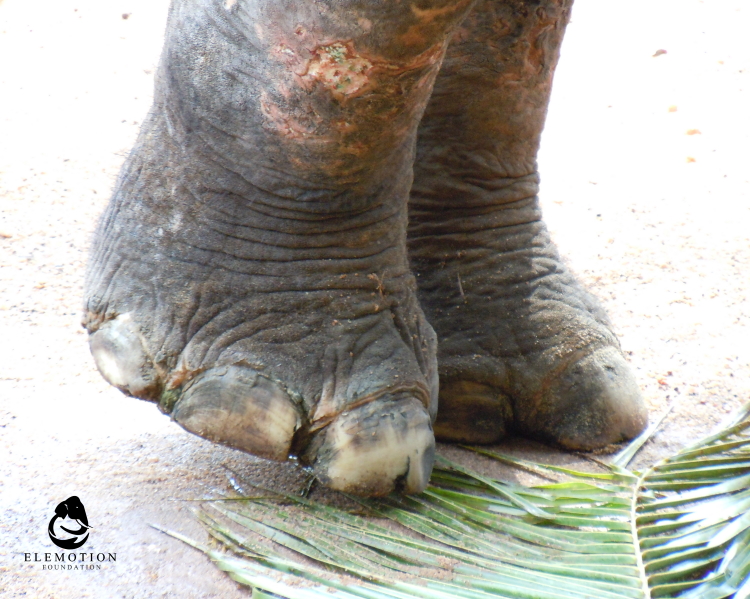Riding
Elephant back riding is a popular tourist activity
Elephant back riding, also called trekking or elephant back safari, is a popular tourist activity. Tourists sit in a ‘chair’ attached to an elephant’s back and ride through Asia’s forests. In countries where traditional types of work are disappearing, such as logging and transport, elephant owners turn to riding as a way to make an income.
The dangers of riding
Did you know an elephant’s spine is not designed to support heavy loads? While there have been no studies to prove putting a chair on an elephant’s back causes physical injury, improper riding is harmful. Oftentimes overworked, the heavily burdened elephants are made to walk repeated treks throughout the day without access to food or clean water. Constant rubbing of their harnesses or improper equipment causes skin soars and dangerous infections. When new mothers are working, their babies instinctively struggle to follow them throughout their long workdays. Under this stress, a mother may cease to lactate. Needless to say, the mortality rate is high for those baby elephants.
The quality of riding equipment, elephant care, and management techniques varies greatly from country to country. For example, in Vietnam’s Central Highland area and Myanmar, a padding of soft tree bark is used as a cushion between the form fitting chair and the elephant’s back. The elephants are generally well cared for and are returned to the forest before dark to forage for the night. Sri Lanka’s safari back elephants are not so lucky. Many spend long hours tied next to a post or tree waiting for the next customer. Crude metal cages laid over a mattress are secured tightly with ropes around the elephant’s abdomen and chest. Foot infections and chain wounds are regularly neglected. See video below. In Thailand, elephants may travel over 300kms to find work in a trekking camp. Many trekking camps in Thailand do not provide proper care for their working elephants. Access to food, shade, and water is often limited.
What do you do?
Consider alternative types of nature tours. If an elephant trek is part of your package, use your time and money wisely for the good of the elephant. Ask the chair to be removed from its back. Tell the operator that you would prefer to see your elephant in a natural state. You many even try asking to accompany your elephant back to the forest. Perhaps you can enjoy watching her graze or bathe. If the operator refuses, ask for your money back.
If you see any of the following, please tell them that you are unhappy with the conditions and you will not come back or recommend the camp. Absolutely no more than 150kgs, or two adults, should be used in riding for no more than 4 hours per day. Puncture wounds or bloody spots on an elephant’s head indicates an overly aggressive use of the hook. Are any of the elephants limping or avoiding to put weight on part of a foot? Do the enclosures look clean and provide shade from the sun? Is there food and water available? Are many of the elephants showing signs of stress by swaying or rocking? Do any of the elephants look completely exhausted or dehydrated with their trunks laying limp on the ground? Do any of the elephants look ill or too thin? If you can clearly see ribs or protruding hips and shoulder blades, the elephant may be underweight. A visible spinal column is not necessarily an indicator of malnourishment. An animal in musth or a mother with a nursing baby should never be working.
Please remember, your personal safety cannot be guaranteed when trekking. How do you know if your elephant is sick, aggressive, a new mother, or pregnant? Tourist injuries during trekking expeditions happen every few months, but are rarely reported. Click these links to read about deadly incidents. incident1 incident2
What About Boycotting All Elephant Riding?
Boycotting means walking a very fine line. With the exception of ‘safari back riding’ in Sri Lanka and elephants found in urban areas, Elemotion Foundation does not support an across the board boycott of elephant riding. For us, it depends on the case. For example, some elephants and their human families depend on riding income to survive. In these cases, refusing to patronize riding may actually penalize these elephants. For these elephants and families, we must have positive elephant tourism alternatives available before we ask them to stop riding. On the other hand, some elephants are owned by wealthy individuals or tour operators who exploit them for more money. In these cases, boycotting riding is definitely appropriate. As a tourist, it is almost impossible to know which is the case.
Without proper background knowledge, making your decision can be very confusing. Therefore, if you decide to patronize these establishments, we recommend visiting the elephants without riding them. See the above section about how to use your time and money wisely for the good of the elephant. This will hopefully send a positive message to the operator without financially penalizing the elephants and their families.
The future of riding…
Elemotion Foundation notes the great successes and popularity of non-riding captive elephant sanctuaries and parks. We do not believe elephant riding is a necessity while these other models have proven wildly successful. With changes in management techniques and mahout training, it could be possible to transform many riding camps into successful, humane non-riding establishments.
Elemotion Foundation has researched riding in Vietnam, Cambodia, Myanmar, mainland Malaysia, Thailand, and Sri Lanka. Riding is an important and difficult subject we continue to research and document. If you have any questions, please feel free to contact us.








